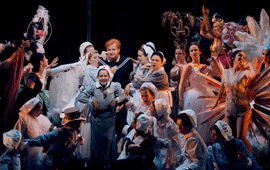> [Archived] Chronicles

Bayreuth Five - Parsifal
The ticket demand for this super production was always great. This summer's performance was played for the last time during the Bayreuth festival, and for the future, a new version will be prepared. I have never imagined that what I have seen on the stage in Bayreuth could be possible on an opera stage. I had the feeling I was watching a film, the fast pace of the scenes, the horizontal and vertical movement of the decors, everything was profoundly amazing.
What Stefan Herheim conceived is very different from what Richard Wagner wanted. For the 1882 Parsifal the composer asked the audience not to applaud but to consider the performance as a mass from where one leaves shaken, changed for the better, but more importantly, leaves silently. I remember I have attended these types of silent performances and the sensation was overwhelming. Today, Stefan Herheim asks us to watch, performed on a Wagnerian score, a history of a German nation, with its successes and its downfalls, with its accomplishments and fatal errors. I remember as a directorial/scenic leit-motive (here too we are in Wagner's world) a bed situated in the decor that reproduces the back of the Wahnfried's villa from Bayreuth on the exact place of the composer's tomb. Everything begins, ends and begins again in this bed: here Herzeleide, Parsifal's mother, dies, here Amfortas sins, here Parsifal is seduced by a Kundry, who appears either as a governess or as Marlene Dietrich with black wings, here, strange characters with sometimes obscure symbols, always appear and disappear. Near the bed pass the Jews on their way to concentration camps, everyone with a suitcase in their hands, and the same bed multiplies in several copies when Klingsor garden (here a transvestite in tuxedo jacket and bear feet with red stockings with garter belts) is transformed in a hospital ward and then in a brothel cabaret scene.
Is this Parsifal in the spirit of Wagnerian aesthetics and philosophy? Certainly not. Is this tormented, twisted, loaded and overwhelming version of a performance one possible for the theatre? It was proven that it can be, the performance was real, it was seen with maximum interest and highly commented, one might enjoy it or not but the future history of Bayreuth festival cannot ignore it. The special attention that this Festival has given this famous production of Parsifal, famous especially thanks to Stefan Herheim's direction, is evident also because, for the first time on the Bayreuth stage, on 11th August, the opera was broadcast live in over fifty movie theatres around Germany.
Translated by Florina Sămulescu
MTTLC, Bucharest University














